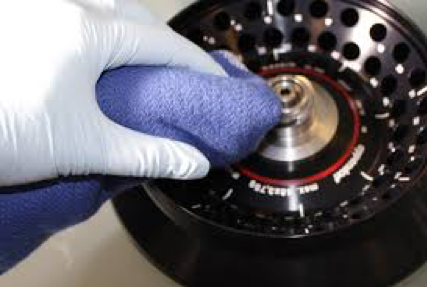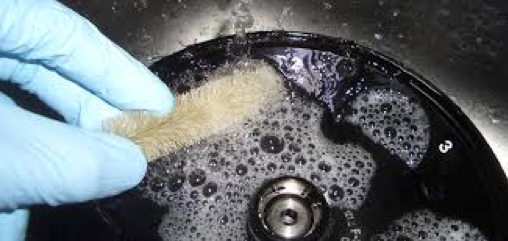 Nils Schoof, lab manager for Dr. Ann Chahroudi’s research group, provides in this article a collection of good laboratory practices that the Chahroudi lab members follow to ensure that centrifuges are working properly and are decontaminated regularly.
Nils Schoof, lab manager for Dr. Ann Chahroudi’s research group, provides in this article a collection of good laboratory practices that the Chahroudi lab members follow to ensure that centrifuges are working properly and are decontaminated regularly.
Centrifuge maintenance is an important everyday practice to maintain optimal condition and safety in every research laboratory.
Regular cleaning and maintenance:
- During centrifugation contamination with salts, chemicals and/or samples which contain infectious agents may occur.
- Long-term exposure of aggressive chemicals can develop corrosive spots on rotors and rotor-buckets.
- Advanced corrosion on rotors or buckets makes centrifugation processes unsafe.
- Every biological spill, no matter how minor, can lead to formation of aerosols and presents enough exposure risk to every individual working with the equipment.
One good laboratory practice followed by the Chahroudi researchers is to post a maintenance and cleaning schedule that includes all members of the lab. While developing the schedule we made sure to follow the manufacturer’s recommendations to avoid damage to essential centrifuge parts due to the use of unsuited disinfection chemicals or cleaning equipment. Here is the guidance provided to our lab members:
- The outside of the centrifuge should be cleaned daily.
-
- Don appropriate PPE, wipe the surface using neutral agents for cleaning and disinfection (e.g. see Emory Biosafety Manual Appendix D for characteristics of selected disinfectants).
- Centrifuge rotors, adapters, buckets, aerosol tide lids and rubber seals should be cleaned weekly or immediately in the event of any contamination.
-
- If a biological spill occurs, don appropriate PPE. Give the aerosol time to settle, do not open aerosol tide lids outside the BSC and use EHSO/manufacturer approved disinfectant to clean the contaminated parts following the lab’s EHSO approved SOP.
- During weekly cleaning, don appropriate PPE and remove rotor, adapters, buckets and aerosol tide lids from the centrifuge. Wipe the parts using diluted neutral alcohol-based disinfectant by using a lint-free cloth. Prepare warm water and a mild detergent, clean parts with a plastic scrub pad or stiff test tube brush, avoid immersing the rotor in water. Rinse parts with distilled water and place on absorbent cloth to dry before next use.
- Once per month, parts should be autoclaved at 121°C (check with manufacturer first to avoid equipment damage, check aerosol tide lid tightness after each run).
- The inside of the centrifuge and any water collection pans can be cleaned on a monthly basis or immediately if there is contamination due to a spill.
-
- In the event of a biological spill/breakage, don appropriate PPE. Give the aerosol time to settle, should there be broken glass/plastic: Retrieve the bigger pieces with forceps, remove small and powder shards with a damp lint-free cloth. Absorb fluids with a paper towel, spray with EPA-approved disinfectant and subsequently, seal the material in a biohazard bag for safe disposal.
- During monthly cleaning, don appropriate PPE, spray a lint-free cloth with neutral agents for cleaning and disinfection (e.g. diluted neutral alcohol-based disinfectant, EHSO approved disinfectant). Wipe the rotor chamber and sealing, remove any stains or contaminations. Wipe with distilled water but do not flood the rotor chamber of the centrifuge, ensure to dry every part well.
 After each cleaning re-apply a small amount of centrifuge lubricant. Lubricate bucket grooves, pivots of swing-bucket rotors, and rubber seals. The rotor chamber sealing can be lubricated as well, especially after disinfection with ethanol. Please use glycerol or talcum for lubrication. Lubricate the threads of the fixed angle rotors after cleaning and autoclaving. Light waxing of the rotor surface as well as the chamber may also extend the lifetime of the equipment.
After each cleaning re-apply a small amount of centrifuge lubricant. Lubricate bucket grooves, pivots of swing-bucket rotors, and rubber seals. The rotor chamber sealing can be lubricated as well, especially after disinfection with ethanol. Please use glycerol or talcum for lubrication. Lubricate the threads of the fixed angle rotors after cleaning and autoclaving. Light waxing of the rotor surface as well as the chamber may also extend the lifetime of the equipment.
Additional recommended work practices for using Centrifuges can be found in the Emory Biosafety Manual at www.ehso.emory.edu/documents.

